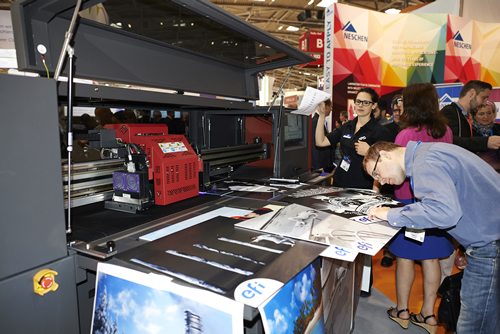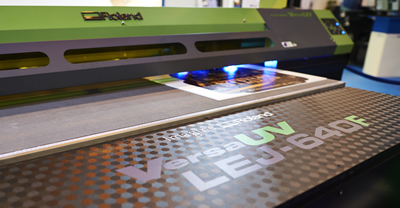A growing number of UV-curable printers are using LEDs but is this trend set to continue? Nessan Cleary reports.
An enormous amount of technology goes into keeping inks wet enough to be able to lay them down onto a substrate without blocking the nozzles. But almost as much thought also goes into drying those inks without damaging the media. The way that the ink dries has a direct affect on the look of the image in terms of its colour saturation and overall glossiness so that the ability to control the drying system is a vital part of designing a printer.
Except of course that UV inks don’t actually dry - they cure through a chemical reaction called polymerization. The inks contain photo initiators, which produce free radicals when exposed to UV light. These free radicals then force the major components of the inks - monomers and oligomers - to cross-link together, turning the ink into a tough solid and simultaneously bonding it to the substrate surface.
Obviously the UV light source is a crucial component of a printer, with most vendors opting to use mercury vapour or metal halide lamps that are capable of delivering a lot of light in a controllable manner. But increasingly printer vendors are turning to LEDs - Light Emitting Diodes - which are a form of semiconductor capable of producing light when connected to an electric current.
The main advantage of an LED is that being a solid material it's a lot less likely to break or wear out easily as a lamp does. In fact LEDs typically last for over 15,000 to 20,000 hours, compared with just 1000 hours for the average mercury or metal halide lamps.
But LEDs are also much more controllable. They can be turned on or off instantly with no time wasted waiting for the lamps to come up to temperature, which makes the printers considerably more productive. Moreover, because there’s no waiting around, all of the lifespan of the LEDs goes directly into printing so it’s unlikely that the LEDs would have to be replaced during the life of the printer. It’s also worth noting that since there’s no degradation of the lamps over time you get their full performance up until the point they fail, unlike a conventional lamp, which has to be monitored and replaced as the performance tails off.
LED systems also produce less heat than conventional lamps so they can be used with a greater range of heat sensitive materials, such as thinner plastics.
In addition, LEDs use considerably less power when they’re on, and only need to be on when actually curing, which adds up to a lower electricity bill. To prove the point, last year Fogra tested an EFI 3.2m wide GS3250LX Pro and found energy savings of up to 82% over printers using conventional curing lamps.
Obviously, cutting down the energy usage is good for the environment as well as the bottom line. Also, there’s no need to dispose of the mercury used in the lamps, which also benefits the environment. On top of this, there’s no ozone or other harmful gases associated with LEDs and no need for any additional ventilation.
 So far so good, but there are a couple of issues to be aware of. Most UV systems need a considerable amount of light to get the curing process going, which is why conventional lamps have to be monitored and replaced as they start to fade. But most LEDs are only capable of producing a relatively low light intensity, one reason why they first appeared on the slower, entry-level machines.
So far so good, but there are a couple of issues to be aware of. Most UV systems need a considerable amount of light to get the curing process going, which is why conventional lamps have to be monitored and replaced as they start to fade. But most LEDs are only capable of producing a relatively low light intensity, one reason why they first appeared on the slower, entry-level machines.
This situation is improving, partly because of ongoing improvements to LED technology leading to higher light outputs. But also a number of ink manufacturers have developed more sensitive inks specifically for working with LEDs.
Stephen Emery, director of ink sales and marketing for EFI says that inks have to be formulated differently for use with LED curing, explaining: “The main change is the initiator which responds to be wave length to start the cross linking so we need to make sure that we have the proper photo initiator to respond to the LED wavelength.”
Inevitably, these inks tend to be slightly more expensive than standard inks, though most manufacturers say that ink prices will fall as the use of LED curing grows.
Some vendors have also turned to pining to get around the low power problem. This means that the LED only has to partially cure the ink immediately after its laid down, followed by a more powerful LED or a mercury vapour lamp for the final cure. But because the pining lamp has already started the curing process, this doesn’t need to be as powerful, saving on energy costs. Also, pining immediately after printing helps keep the dots sharp for a better image quality.
This approach can be seen on EFI’s HS100 Pro, a 3.2m printer capable of producing 100 rigid boards per hour. This uses LEDs for pining with mercury vapour lamps for the final cure.
Last year EFI used LED for a complete curing system on an entry-level printer, the H1625 LED. This prints CMYK plus two sets of white ink, with up to eight levels of greyscale. It has a print width of 1.6m and can print at up to 42m2/hr.
EFI also uses LED curing for a number of its GS series of superwide-format printers, including the GS5500LXr Pro, a 5m-wide hybrid printer with multiple drop sizes starting at seven picolitre, and eight colours plus an optional white.
Fujifilm used LEDs for its Acuity LED 1600, a roll-fed printer capable of 20m2/hr. It uses Fuji Dimatix Q class heads with one head per colour, and uses light cyan and light magenta plus white and clear inks as well as CMYK.
Tudor Morgan, European systems marketing manager for Fujifilm Speciality Ink Systems, says that a major factor in using LED curing was to save weight: “If you put a mercury vapour lamp on a machine of that size, then the additional weight on the carriage means that you have to strengthen that, which puts the price up.”
He adds that because of the advantages of LED curing Fujifilm had already been working on developing suitable inks, noting: “We could cure better, and for white and varnish, and not lose any flexibility at that print speed.”
Fujifilm has formulated its ink with a monofunctional monomer, which has high elongation and adhesion, so that its flexible enough for roll fed substrates. There are two LED units - one to pin the inks, which allows them to penetrate the media surface, and another to fully cure them, which gives greater adhesion for PVC media.
Mimaki has used LEDs in most of its UV printers, including the recently launched JFX200, an entry-level flatbed that can produce up to 25m2/hr. It boasts a choice of hard or flexible inksets. The same imaging system is also used on the much bigger JFX500, which can run at 60m2/hr, also with LED curing, on a 2100 x 3100mm bed. LED curing is also used for the roll-fed UJV500, which can print at up to 100m2/hr, on flexible media, with enough stretch for use in vehicle wrapping applications.
Roland has used LED curing for a number of its printers including the LEJ640 hybrid printer, as well as the flatbed derivative of this, the 640F. These use Roland’s new Eco UV inks, which print to both rigid and flexible media. Roland also uses LED curing for its LEC series of print and cut machines.
Mutoh also has a new LED UV hybrid, the VJ-1626UH. This is a 1.6m wide printer that can handle a wide variety of rigid and flexible materials, including heat-sensitive substrates.
So, clearly, there’s a growing number of printer vendors that are using LED curing. Most entry-level wide-format printers are already adopting this technology though it will take a while longer to develop the right combination of ink and curing units for the bigger, more productive printers. But Emery says this trend will continue, adding: “I would say the majority of printers will be replaced by LED.”
{jathumbnail off}


